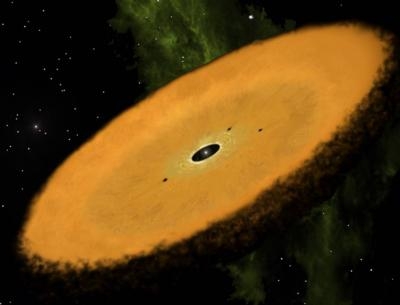Eight Amateur Astronomers Helped Locate The New Area Of Interest
Via a NASA-led citizen science project, eight people with no formal training in astrophysics helped discover what could be a fruitful new place to search for planets outside our solar system – a large disk of gas and dust encircling a star known as a circumstellar disk.

A paper, published in The Astrophysical Journal Letters and coauthored by eight citizen scientists involved in the discovery, describes a newly identified red dwarf star, AWI0005x3s, and its warm circumstellar disk, the kind associated with young planetary systems. Most of the exoplanets, which are planets outside our solar system, that have been imaged to date dwell in disks similar to the one around AWI0005x3s.
The disk and its star are located in what is dubbed the Carina association – a large, loose grouping of similar stars in the Carina Nebula approximately 212 light years from our sun. Its relative proximity to Earth will make it easier to conduct follow-on studies.
"Most disks of this kind fade away in less than 30 million years," said Steven Silverberg, a graduate student at Oklahoma University and lead author of the paper. "This particular red dwarf is a candidate member of the Carina association, which would make it around 45 million years old. It's the oldest red dwarf system with a disk we've seen in one of these associations."
Since the launch of NASA’s Disk Detective website in January 2014, approximately 30,000 citizen scientists have performed roughly two million classifications of stellar objects, including those that led to this discovery. Through Disk Detective, citizen scientists study data from NASA’s Wide-field Infrared Survey Explorer mission (WISE), the agency’s Two-Micron All Sky Survey project, and other stellar surveys.
"Without the help of the citizen scientists examining these objects and finding the good ones, we might never have spotted this object," said Marc Kuchner, an astrophysicist at NASA’s Goddard Space Flight Center in Greenbelt, Maryland, who leads Disk Detective. "The WISE mission alone found 747 million objects, of which we expect a few thousand to be circumstellar disks.”
The eight citizen scientist co-authors, members of an advanced user group, volunteered to help by researching disk candidates. Their data led to the discovery of this new disk.
“I’ve loved astronomy since childhood and wanted to be part of the space program, as did every boy my age,” adds Milton Bosch, a citizen scientist co-author from California. “I feel very fortunate to be part of such a great group of dedicated people, and am thrilled to partake in this adventure of discovery and be a co-author on this paper.”
Disk Detective is a collaboration between NASA, Zooniverse, the University of Oklahoma, University of Córdoba in Argentina, National Astronomical Observatory of Japan, Space Telescope Science Institute, Harvard-Smithsonian Center for Astrophysics, Carnegie Institution of Washington, University of Hawaii and Korea Astronomy and Space Science Institute.
(Image provided with NASA news release)
 NTSB Prelim: Cirrus Design Corp SR20
NTSB Prelim: Cirrus Design Corp SR20 ANN's Daily Aero-Linx (11.30.25)
ANN's Daily Aero-Linx (11.30.25) ANN's Daily Aero-Term (11.30.25): Wind Shear Escape
ANN's Daily Aero-Term (11.30.25): Wind Shear Escape Aero-News: Quote of the Day (11.30.25)
Aero-News: Quote of the Day (11.30.25) Airborne 11.26.25: Bonanza-Baron Fini, Archer v LA NIMBYs, Gogo Loses$$$
Airborne 11.26.25: Bonanza-Baron Fini, Archer v LA NIMBYs, Gogo Loses$$$



